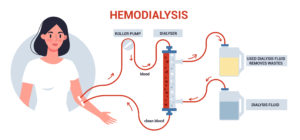Dialysis Access Management
Should a patient require dialysis access management — such as when they are to have a hemodialysis fistula or graft inserted — our team here at Southpark Vascular will create a custom- tailored schedule to ensure the access management process is completed as safely as possible.
Vein Mapping
Vein mapping is a diagnostic method that utilizes ultrasound technology. A tool designed to help our team determine where best to place a patient’s graft or fistula; the process involves the monitoring of blood flow through the patient’s arteries. It may also be used to guide needle and/other catheter placement processes.
 Hemodialysis and Tunneled Catheter Placement
Hemodialysis and Tunneled Catheter Placement
In some cases, a patient’s graft or fistula requires further maturation before it can be properly placed. Should this be the case, we will provide the patient with comprehensive catheter services until the graft/fistula is ready.
Thus, we will use tunneled catheters for the dialysis process. This involves:
● One channel that removes the patient’s blood and dialyzes (purifies) it
● A second channel that returns the blood to the patient once it has gone through the
hemodialysis machine
Tunneled catheters are often placed around a patient’s neck or collarbone and are inserted
using ultrasound guidance.
 Fistulograms
Fistulograms
Fistulograms are completed when the physician has reason to believe the patient’s fistula or graft may, in some way, be obstructing the overall dialysis procedure. Consequently, a fistulogram allows them to assess the access point and determine the best method forward.
Slow blood flow and high venous pressure are two common causes of such a challenge to
dialysis. It may also be caused by…
● A weakened thrill/bruit
● Complications with a cannula
● Prolonged bleeding
● And more